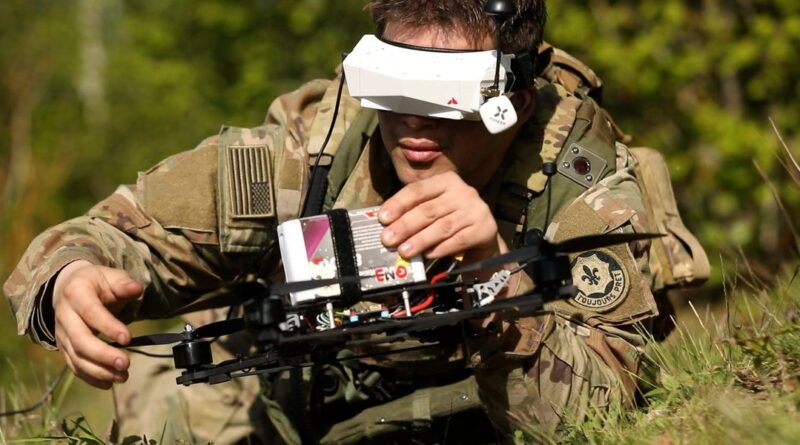Behind the US Army's drone push is broken gear, bad signals, and a lot of lessons that still need to be learned
A lieutenant needed a drone up in the air to get a read on the enemy forces. Responding, a drone operator slipped on his headset, but the video feed was out. It was a no-go for recon.
The quadcopter drone had gotten snagged on a branch during maneuver, and the soldier’s frustrated effort to get it loose apparently damaged the cord. With the drone down, the only option was for soldiers to physically move into position for a visual.
The combat action wasn’t real, but the challenges experienced were. The drone wars are here, and there’s a lot to learn. As the US Army drone pilot told Business Insider’s Graham Flanagan during the recent exercise in southern Germany, issues arise because “we’re still so new to having drones with us.”
Drone warfare has dominated the war in Ukraineand now, the Army is increasingly recognizing it as a key element of future warfare. It is a capability that can’t be ignored; however, the service has a lot of catching up to do.
During the exercise at the Hohenfels Training Area, about 400 miles from the western border of Ukraine, where drones are constantly buzzing about the battlefield, Business Insider got an up-close look at soldiers with the 2nd Cavalry Regiment testing their own drones as part of a larger mission to capture an area of defended trenches.
The drones themselves cost just about $500 and are assembled by drone pilots in the regiment at the Drone Innovation Cell in Vilseck. “All of them were completely designed, built, and flown by 2CR soldiers,” Capt. Ronan Sefton, an intelligence officer with 2CR, told Business Insider.
Off-the-shelf Chinese-made drones like the Russians and Ukrainians have used in battle aren’t an option, so for the Army, that means starting from scratch.
A US Army soldier holding a quadcopter drone. Screenshot/Business Insider/Graham Flanagan
At the innovation cell, soldiers donned headsets lighter than the ones commonly used for virtual reality or video games and tested the drones. Developing the systems on the spot, the soldiers switched out parts on quadcopters, designed and 3D printed components, and demonstrated how pilots can attach and drop payloads. The Army recently dropped a live grenade from a drone for the first time, taking a tactic seen extensively in Ukraine and applying it.
Problems began to arise when it was time to take them onto the “battlefield.”
The first occurred when Pfc. Jaazaniah Aguigui attached his quadcopter to the outside of his rucksack. “What I’m concerned about is all this,” said Sgt. Maj. Paul Hamako, pointing to the propellers on the drone, “is going to get, you know, you’re going to get in the woodline, and it’s going to get hung up on stuff.”
He called it. When Aguigui was following his fellow soldiers through the forest of the training area later, that exact scenario occurred: his drone was caught in the thick vines of a shrub, and he had to quickly rip the vine apart to keep moving.
The hiccup, he suspected, is what led to one of the drone’s cables malfunctioning later when he needed it to survey the area. “I wasn’t even paying attention to the tree, kind of got tunnel vision and wanted to just follow the dude in front of me and ended up getting caught,” he told Business Insider.
He explained that transporting the drone on the outside of the rucksack was something he hoped would work, but the drone being exposed to the environment turned out to be a problem. What might be fine for an open field gets complicated in the woods.
A US Army drone operator wears a headset as he pilots a quadcopter. Screenshot/Business Insider/Graham Flanagan
Army drone operators encountered several other problems with their drones during the exercise. One encountered range trouble and a loss of GPS. Another pilot tossed on a headset for a first-person-view drone but ran into problems with a bad signal connection on the first attempt to scout the area, with a ridgeline causing trouble.
Tinkering with a drone in the field, Pfc. Caleb Johns realized he didn’t have enough screws on hand for the work. “So either way, we can’t fly anymore,” he said.
They went through multiple drones trying to support the reconnaissance operations but ran into a string of issues before they could get a pair up to complete the mission. These connectivity and hardware issues discovered during testing of the drones at the exercise were important feedback, though, helping prepare the Army for a kind of warfare that has exploded onto the scene.
“We have to work through some problems in the field because we’re innovating at a speed that we kind of haven’t seen before in the past,” Hamako explained of the ongoing work, adding that “it’s a really great thing that we’re doing right now, and that’s a good problem to have.”
A US Army drone pilot uses a controller to launch an FPV drone. Screenshot/Business Insider/Graham Flanagan
And it wasn’t all struggles. Army pilots executed recon tasks and harassed hostile forces using drones. But broadly, the US military has a lot to learn about using small, cheap uncrewed aerial systems like those that have become a defining element of war in Ukraine.
There are growing pains in learning drone warfarein learning from the fighting in Ukraine, where both sides have ramped up their use of all types of drones and uncrewed vehicles for intelligence and conducting strike missions.
The Army appears to be behind the curve, but it’s embracing the use of these drones in a big way as part of its massive transformation initiative unveiled earlier this year, which heavily focuses on drones with plans to give every division 1,000 of them and counter-UAS systems within the next two years.
The transformation is shaping up to be one of the Army’s largest overhauls since the Cold War’s end and is estimated to cost about $36 billion over the next five years. Army officials have said it is designed to increase lethality and readiness in the service and is focused on the needs of individual warfighters.
Across the Army, soldiers are learning how to operate drones through trial and error in the field. In the Indo-Pacific, for example, soldiers have been learning how weather and temperature impact flight duration and takeoff. The military is also adapting to the dynamics of the drone market, long dominated by Chinese companies, and pushing US defense companies to produce more drones and essential components.





